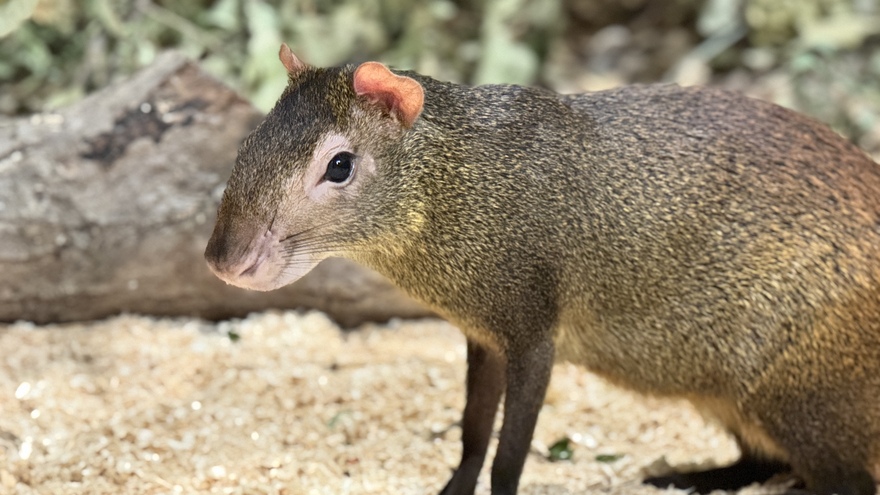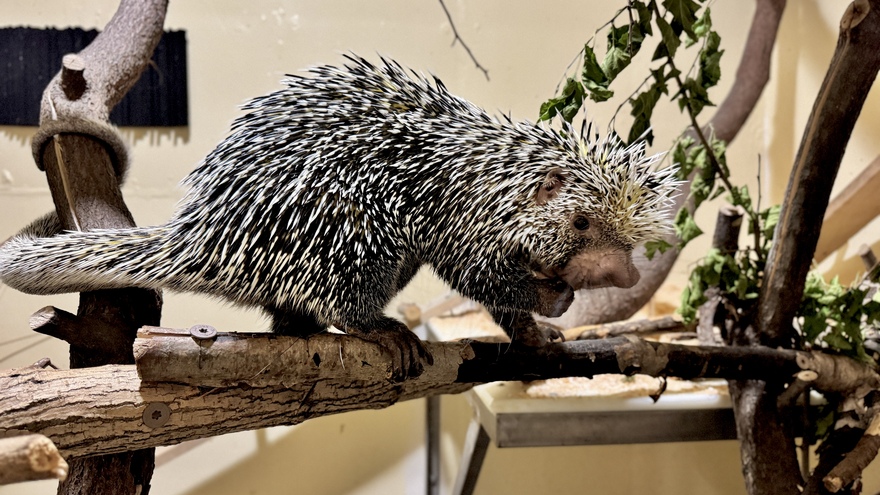
Fernando the Agouti
The construction site of the future Primate Forest is a dramatic sight for Zoo visitors and a quickly evolving reminder of new Zoo adventures to come. In the meantime, the residents of the former RainForest continue to receive superb care – some in their existing habitats, some in other facilities around the Zoo. It has been a unique challenge for the Zoo’s curators and keepers, and an opportunity to learn some new things about the animals in their care.
Upon its closure to the public, the RainForest’s daily operations changed quickly – and the Animal Care team was faced with a logistical puzzle. Associate Curator Lynn Koscielny said of coordinating new habitat spaces, "It took working with every other associate curator at the Zoo. We looked at every animal we had to move and every space available in the Zoo.” She touted the versatility of the Sarah Allison Steffee Center for Veterinary Medicine, where the capybara, anteater, and otters are currently housed. This valuable facility, however, must remain available for caring for sick or injured animals as well as quarantining new arrivals to the Zoo, so the team was careful not to overburden it.
In addition to the Sarah Allison Steffee Center, the former veterinary hospital at the top of the hill still functions as a space for housing animals. Many of the birds from the RainForest’s aviary currently live in this building; moving them was a concerted effort that spanned a couple days. Leading up to the move, keepers had been placing food for the fruit-eating birds in an open “catch cage,” to accustom them to entering the cage to eat. That way, when moving day came they could be enclosed simply enough. “Some of the other animals took a little bit of finessing,” said Animal Keeper Kim Jansen. “The ibis and sunbittern are meat-eating birds that don’t utilize the catch cage. So for those, we’d gather as many people as possible, grab these big nets, and have people stationed at different spots.” Others, like Stanley the turaco “who just really, really loves people” were team players who made the move easy on the staff.

Hamilton the Aracari
Jansen praised the collaborative spirit among keepers throughout the relocation process. “We have a great team at the RainForest. Everybody's super willing to help out, even if it's not their area or their specialty.” Now, with animals spending their time in various facilities across the Zoo, some of these keepers are traveling between places to care for the species in their charge and working hand-in-hand with the keepers in those other areas as well.
A common question for the Animal Care team is, do the animals miss the visitors? Animal Keeper Kristy Becka said that while reptiles don’t necessarily miss people, they certainly notice the change. "The dwarf crocodile reacts to Kevin (the Project Manager overseeing Primate Forest) - she's done it a couple times. She's had hundreds of kids walking by and did not react, and now Kevin just walks by in his vest and she's visibly noticing him." Becka also noted that the gharials tend to stay behind-the-scenes until construction activity ends in the afternoon, when they come out to enjoy their habitat. She is using the extra time without guests to do more training and relationship-building activities with the two gharials.
In contrast to the reptiles, orangutans are keen on interaction with visitors. “We noticed that when the construction workers were nearby doing their stuff, all the orangutans were kind of suction-cupped to the glass, watching them,” Jansen said. “Kayla and especially Kera really enjoy watching people. After making some of these observations, we thought, how can we work this out?” Together with Volunteer Services, the Animal Care team set up a unique opportunity for Zoo volunteers to visit the orangutans twice a week – an enriching experience for orangutans and people alike.
The animals are not the only ones adjusting to fewer visitors. Koscielny quipped, “Several times I've walked into the building and seen ladders without workers on them and there’s Kristy in front of the Burmese python talking to an audience of five construction workers, and it’s like, ‘Kristy, they have a job here!’” It seems everyone is learning a few new things as construction forges ahead.

Emma the prehensile-tailed porcupine
Clearly, Primate Forest construction has brought forth a number of changes and challenges for the Zoo’s Animal Care team. As they navigate their current “normal,” they are also looking forward to the new opportunities Primate Forest will present. Jansen is excited about “health management hubs” that will invite guests to observe the Zoo’s animal care experts as they work with the orangutans on voluntary positive reinforcement training, perform tests such as EKGs, ultrasounds, and pulse readings, and administer care such as injections and nebulizer treatments. “All of this is currently done behind-the-scenes, so it will be great to be able to showcase it,” she said.
Becka, who has participated in the Zoo’s efforts in reptile conservation since she began as an intern at 19, is eager to share some of that work with Zoo guests. "We’re going to feature garter snakes, Puerto Rican crested toads, and spotted turtles. Visitors will get to see Puerto Rican crested toad breeding tanks, tadpole development, how we ship them (to Puerto Rico for release into the wild), and the everyday care. I’m excited that kids are going to be able to see the work and maybe get into amphibians and reptiles.”
There is no shortage of things to be excited about in Primate Forest. As construction progresses and its innovative animal habitats and guest experiences begin to take shape, the animal keepers and curators dedicated to the former RainForest’s residents continue to provide exemplary care and thoughtful enrichment for the animals – and sometimes, impromptu educational sessions for the construction team.


